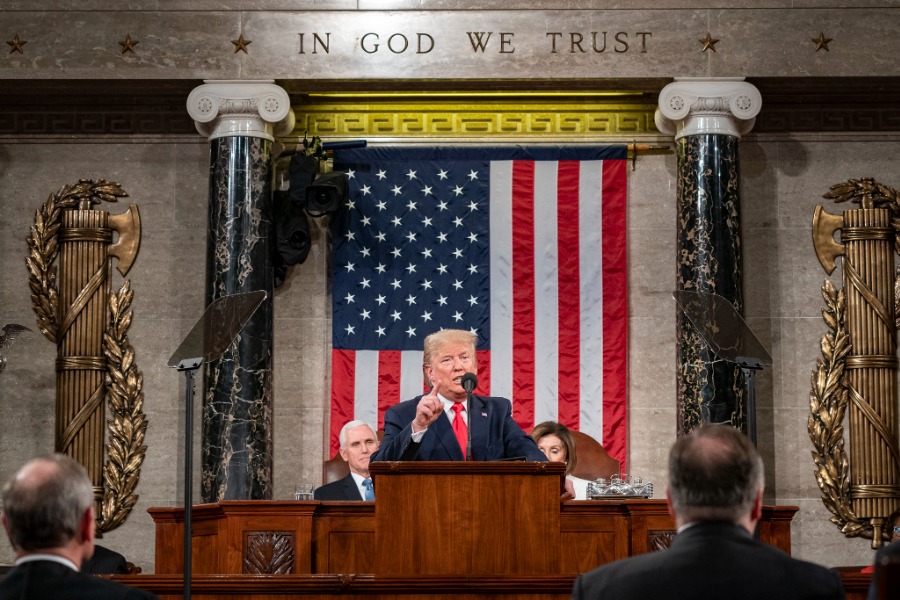Toward Transparency of Legal Position and Process and a White House Obligation to Disclose
A White House’s responsibility to explain the legal basis for military actions such as the Syria missile strikes is dangerously undefined. This is not a problem unique to the Trump Administration. Nor do the differences between administrations in the choice, the structure, or timing of transparency fall out exclusively among party lines. What has emerged is a transparency regime shaped largely by broad discretion and perceived political necessity.

Published by The Lawfare Institute
in Cooperation With

A White House’s responsibility to explain the legal basis for military actions such as the Syria missile strikes is dangerously undefined. This is not a problem unique to the Trump Administration. Nor do the differences between administrations in the choice, the structure, or timing of transparency fall out exclusively among party lines. What has emerged is a transparency regime shaped largely by broad discretion and perceived political necessity. The White House explains what seems to demand explanation but as much as possible in its own time and its own way, with pressure to say more rather than less coming from the media and the Congress. The degree of pressure and its impact vary widely. The results are, at best, mixed.
In the immediate case of the Syria strikes, the Administration seems to have concluded that it did not need to clearly state its legal justification. The President’s announcement of the action referred generally to the “vital national interest” served by protecting the civilian population and enforcing treaties and norms against the use of chemical weapons. Lawyers likely passed on the remarks and left their imprint: the explanation tracks grounds previously asserted, in other, analogous situations, for the exercise of Article II authority. But the involvement of lawyers has been left to inference. The President’s remarks did not take up in explicit terms the legal grounds for the action, which were also not the subject of any subsequent White House briefing or public disclosure. And the Administration has altogether ignored questions of international law presented by the strikes
In the past, administrations have also largely proceeded as they wished to disclose as much as they chose, and on their own terms. When the Obama Administration elected to seek congressional authority for a military response to the Syrian government’s use of chemical weapons, the White House Counsel presented the President’s legal position in an interview with the New York Times’s Charlie Savage. As the Administration’s view was explained to Savage, the President believed that he had the authority to act unilaterally but had concluded that, in the particular circumstances, Congress’s blessing would enhance the “legitimacy” of executive action. It was through this press interview that the administration first laid out its legal position.
This question of how the executive accounts for its actions under law encompasses process as well as substance. There are now disagreements over the role of Office of Legal Counsel, a topic on which I have written, and with these have come strongly expressed concerns that legal considerations will now predictably yield to White House policy imperatives and political pressure. The White House Counsel, as chief enabler, is seen as crowding out more independent sources of advice and authority on the limits of executive action. Whatever the view one takes of the process by which these legal decisions are taken, these worries are legitimate. The credibility of a legal position will always depend, in part, on the credibility of the legal decision-making process—on an understanding of how it was developed and by whom. The absence of this explanation feeds the suspicion that the administration’s legal posture is just a talking point, managed primarily as a communications and political challenge.
The Libya case (with which I was involved as White House Counsel) brings out clearly the importance of matching substantive with process disclosure. The Obama Administration adopted a controversial position on the application of the War Powers Act to the U.S. role in the NATO military initiative against the Qadaffi regime. It committed considerable time to the presentation and defense of its position, most notably in congressional testimony by the State Department legal adviser, Harold Koh. But a separate line of controversy erupted over the internal deliberative process through which this position was developed and adopted. The New York Times reported a split over the legal question among senior administration legal advisers and the President’s decision to accept the advice of the White House Counsel and State Legal Adviser over competing views, including OLC’s. Critics of the Administration’s stance on the substance of the law saw its deficiencies as integrally related to their view of the irregularity of the process.
These interdependent questions of process and law at the executive level are not new. In the Cuban Missile Crisis, President Kennedy and his advisers established a special committee on the crisis and tapped legal advisers across the government to produce a rationale to support a strong response to the Soviet missile emplacement. The President rejected counsel he considered politically unhelpful and embraced theories of dubious merit. His address to the nation relied on a smattering of rationales, including the right to self-defense. Another example, still more distant in time, is President Roosevelt’s maneuvers around clear legal prohibitions to arrange for the bases-for-destroyers exchange with Great Britain in 1940. The President’s advisers ghostwrote an “independent” public justification placed in the press in the name of prominent lawyers outside the government; the President hand-edited the draft eventually prepared by Attorney General Robert Jackson, who was operating under intense pressure to give the desired answer. Neither case provides a model internal deliberative process on legal issues, and it is open to question whether the Kennedy Administration, which viewed construction of its legal position as little more than a political imperative, was forthright in its statement of the authority on which it was acting.
By the 1970s, assumptions about the legitimate structure of the executive legal decision-making process began to change, and it was increasingly accepted or believed that Presidents would look in the first instance to the professional corps of lawyers for independent legal advice. OLC was at the center of this development. Now we see change again; OLC’s role is less certain. And even where OLC has been the decisive source of advice on a sensitive national security issue, as was the case in the production of opinions on what the George W. Bush administration termed “enhanced interrogation” and its critics denounced as “torture,” questions were raised about White House interference with a fully independent legal review.
Some commentators, notably Yale Professor Ackerman, insist that the answer lies in redesigned institutional safeguards for independent legal advice. He favors a “Tribunal,” structured like a court: on one version, the Tribunal members would be nominated by the president and confirmed by the Senate, and its opinions, which Congress could also request, would be binding on the executive.
There is little—if any—reason to believe that this Administration, any more than its predecessors, will entertain as practical or advisable this or any similar proposal. Presidents believe themselves to “own” their national security decisions, especially in a crisis setting. If executives must make these choices and answer for them, they will resist a proposal like Ackerman’s which would deny a president the capacity to direct the widest-ranging exploration of potential legal options. The OLC’s own Statement of Best Practices has acknowledged a responsibility to “facilitate” the President’s implementation of his policies, subject to the Office’s obligation to tender its “best view” or understanding of the law. Hence, “OLC will, where possible and appropriate, seek to recommend lawful alternatives to Executive Branch proposals that it decides would be unlawful.” And yet, as noted, even this construction of the OLC’s role, allowing for it to function as a “facilitator,” has not been sufficient to assure its uncontested primacy in the resolution of critical national security issues.
With more openly direct White House involvement in the legal deliberative process, a clear understanding of the executive’s obligation to disclose in adequate detail the process and substance of its legal decision-making takes on greater importance. The gravitational pull of this White House-centered model may be inescapable, which is certainly what the history across administrations suggests. Of course, at any one time, a White House may feel compelled to minimize or even dispute the degree of control it sought to exercise over the development of legal rationales. Few believe it, and in due course, administrations may give up trying to persuade the skeptics. But it is a more daunting challenge, and the worst of all outcomes, for a president to decline to account for the executive branch’s legal positions or for the structure of its legal decision-making process.
What seems needed now is a protocol or standardized expectation governing the disclosure of legal posture and process. In a recent paper, I have argued for a more realistic view of how a president might organize the legal advisory process to respond to an urgent national security challenge in “crisis.” The White House should be able to establish a legal advisory team that would aid the policymakers in sorting out their options. The team should include OLC but not always at the head of the table: The White House Counsel, or another senior departmental lawyer, might chair the collective effort. To those who hold fast to the older OLC-centric model, this may be a deeply troubling process. And yet if it is likely to reflect actual executive practice, particularly in moments of crisis, it is better—indeed crucial—that the legal rationale be disclosed along with the organization and staffing of the advisory procedure that produced it.
On at least this transparency imperative, experts who have different views on matters of law and policy should agree. It is pressure from this community, coupled with persistent inquiry from the press, which may eventually help establish and enforce a transparency practice or norm. Should this not develop, White Houses asserting more direct control over the legal advisory function will continue to make as they please the choice to disclose, and when, the process and the outcome. Or they may be tempted to believe that they can disclose virtually nothing at all.





